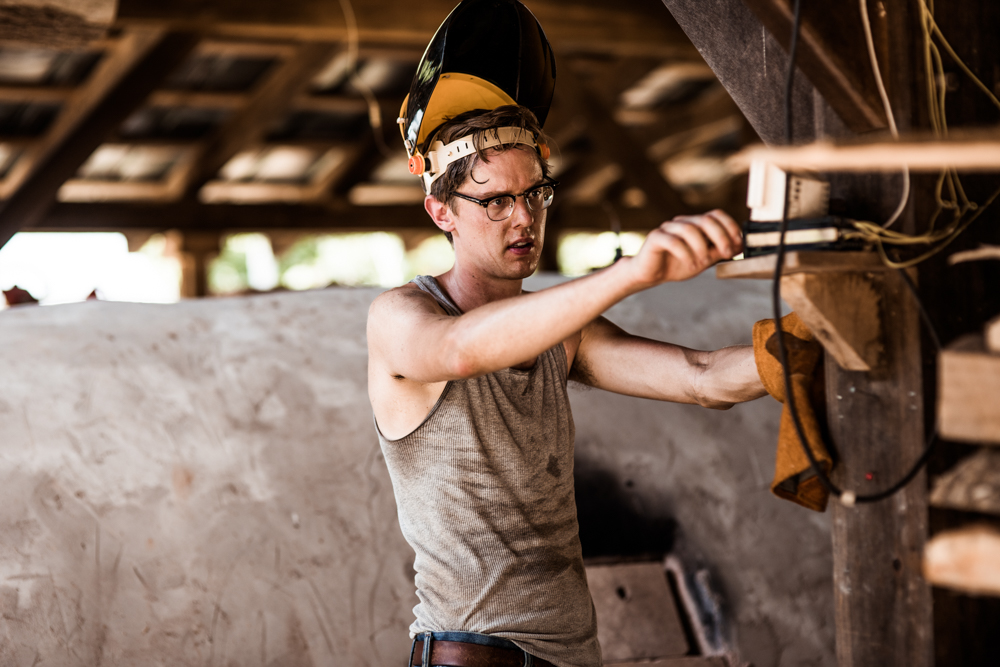Earlier this summer I sat down with Alex and John to talk about East Fork's transition from wood-fired, one-of-a-kind, "country" pottery to a sleek and streamlined gas-fired collection.


Connie: Hey boys.
Alex & John: Hi Connie.
Connie: What sort of pots did you see yourself making when you left your apprenticeships?
John: I had no vision past making the things I knew how to make, which were very traditional forms--all decorated.
Alex: Same. I felt so young and immature. And stupid.
John: Yep. Real stupid.
Connie: How is the new body of work different from what we’ve seen from East Fork in the past?
John: The way I’ve been talking about it to myself is that we’re taking the elements of the old work that we like but stripping them of their vernacular details--turning them into something more universally understandable or appealing or digestible. But...I don’t know if that’s true. And I guess only time will tell if it’s appealing. So maybe there isn’t much that ties it to the old stuff. [Big sigh.] I guess…
Alex: Can I finish your sentence?
John:We’re always finishing each other’s sentences.
Alex: The way that we approach making the work has stayed the same. When we’re grinding at the wheel making 100 or 200 plates, one after another, and we’re still disgruntled with what we’re making because we know we can be doing it better. That’s the same.
Connie: So the common characteristic between the new and the old work is that you’re disgruntled with it. Check.
John: Yeah, it’s the self-loathing.
Alex: No. Yes! Kinda. The simpler you make the form the less room there is for error. So we’re always still searching for a perfect pot.
John: What I think is interesting about this new work is that we take that Mark Hewitt (link) attitude of getting in there and making for 8 hours and producing a ton of work, entirely standardized, by hand…that’s still the same and I think that kind of sets us apart.
Alex: Most pots out there with this tightness of form are made by machine or in a mold. There’s not a lot of handmade pottery made with the rigor and precision that we bring to this.
John: A lot of pots that are made by hand announce that very loudly. On these pots the touch is light, more polished…
Alex: They’ve been made by hands that know so keenly what they’re doing.
Connie: And whose hands in particular have made these pots?
John: Our hands! All of ours!
Alex: The new collection is simply stamped “East Fork”, so there’s no telling who made it. We all really see that as an honor for the apprentices--that their pots don’t have to be “apprentice pots”. Removing your name is a rite of passage of sorts.
Connie: Do you miss decorating?
Alex & John: No!
John: It’s not something I want to forget about completely, but this has been adequately challenging and engaging.
Connie: What makes it so challenging?
John: It takes a lot more organization and rigorous standards to coordinate everyone - to get everyone making exactly the same pot. We’ve got a spreadsheet with all of the pots in the line, all of their weights, and all of their measurements to the millimeter. When we throw things now we throw them to the millimeter. That’s pretty indicative of the change.
Alex: We have so many spreadsheets now.
Connie: What form are you most excited about sharing?
John: I’m really excited about the dinner plates.
Alex: Yeah, big stacks of dinner plates. They’re so different than plates made in the wood kiln. You can pick up fifteen of them and not worry about giving yourself a hernia.
Connie: And I know some chefs around town are excited about your dinner plates, too.
Alex: William Dissen at the Market Place was the first to approach us. We learned a lot making plates for him. Then Patrick O’Cain at Gan Shan. We’re working on a really big project for an Asheville restaurant that we’re really excited about.
John: I love that our apprentices can walk into a restaurant and say “I made that plate.”
Alex: And it’s so wonderful to see the plates in use. It puts the work through its paces. We’re proud it can stand up to that kind of abuse.
Connie: If you could make plates for anyone, who’d it be?
Alex: I’ve got my sights set on Danny Meyer



